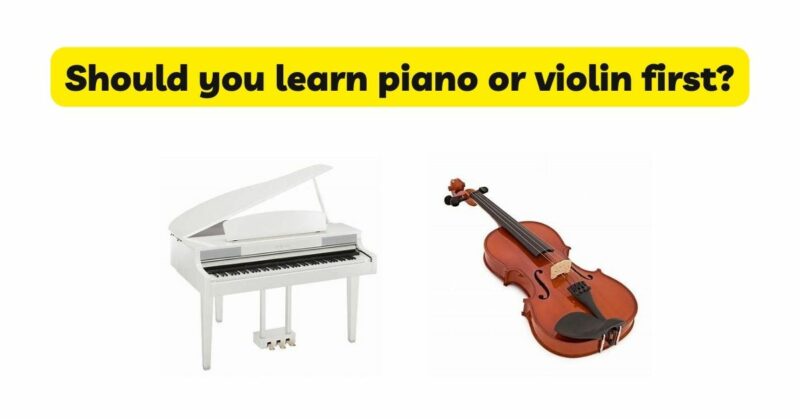Embarking on a musical journey is an exciting endeavor, but the decision of which instrument to learn first can be a daunting task. Among the myriad of options, the piano and the violin stand out as popular choices. Both instruments have their unique characteristics, challenges, and rewards. In this article, we will explore various factors to consider when deciding whether to learn the piano or the violin first. By examining aspects such as instrument characteristics, personal preferences, learning curve, and musical goals, you can make an informed decision that aligns with your passion and aspirations.
- Instrument Characteristics: Understanding the characteristics of the piano and the violin is crucial in determining which instrument to learn first. The piano is a keyboard instrument that produces sound by striking keys, offering a wide range of notes and the ability to play chords, melodies, and harmonies simultaneously. It provides a visual representation of music theory and is often considered a versatile and self-contained instrument. On the other hand, the violin is a string instrument played with a bow, producing a distinct, expressive sound. It requires precise finger placement, bow control, and the development of a strong sense of pitch. Consider which instrument’s characteristics resonate with you and align with your musical preferences.
- Personal Preferences and Musical Goals: Your personal preferences and musical goals should play a significant role in deciding which instrument to learn first. Consider the genres and styles of music that inspire you. If you are drawn to classical music, the violin may be a suitable choice due to its rich classical repertoire. Conversely, if you have a broad interest in various genres such as jazz, pop, or contemporary music, the piano’s versatility may better align with your musical goals. Reflect on the sounds and musical experiences that ignite your passion to guide your decision-making process.
- Learning Curve and Technical Demands: Both the piano and the violin present unique challenges in terms of technique and learning curve. The piano, with its fixed pitch and visual layout of keys, often offers a more straightforward initial learning process. It allows for a clear understanding of music theory, hand coordination, and sight-reading. However, mastering advanced piano techniques, such as playing intricate passages with both hands, requires dedication and practice. On the other hand, the violin has a steeper learning curve due to its physical demands, requiring precise bowing techniques, finger placements, and intonation. It may require regular lessons and guidance to develop proper technique. Consider your patience, commitment, and willingness to tackle technical challenges when deciding which instrument to learn first.
- Availability of Resources and Instruction: Access to quality instruction and learning resources is a vital consideration when choosing an instrument. Research the availability of qualified teachers, music schools, or online platforms that offer comprehensive lessons for piano or violin. Consider the cost, location, and reputation of the resources available to you. Having access to knowledgeable mentors and appropriate learning materials can significantly impact your progress and enjoyment as a musician.
- Practicality and Accessibility: Practicality and accessibility are important factors to consider in your decision-making process. The piano is a large instrument that requires dedicated space in your home, and moving or transporting it can be challenging. On the other hand, the violin is relatively portable, allowing you to practice almost anywhere. Additionally, consider the cost of purchasing or renting an instrument. Pianos tend to be more expensive than violins, especially when considering the space, maintenance, and tuning costs. Evaluate your living situation, available space, and financial considerations to determine the practicality and accessibility of each instrument.
- Musical Support and Collaboration: Consider the musical support and collaborative opportunities associated with each instrument. Learning the piano can provide opportunities for accompanying other musicians, participating in ensembles, or exploring collaborative musical projects. The ability to play chords and provide harmonic support can be valuable when engaging with other instrumentalists or vocalists. Alternatively, learning the violin can open doors to chamber music groups, orchestras, and other collaborative violin ensembles. Consider your desire for musical collaboration and the available opportunities for each instrument.
Conclusion: Deciding whether to learn the piano or the violin first ultimately depends on your personal preferences, musical goals, and circumstances. Both instruments offer unique challenges and rewards, and there is no one-size-fits-all answer. Consider the characteristics of each instrument, your musical aspirations, the learning curve, availability of resources, practicality, and opportunities for collaboration. Reflect on the sounds that resonate with you, the genres that inspire you, and the musical experiences you wish to pursue. Remember that whichever instrument you choose to learn first, the journey of mastering an instrument is filled with joy, dedication, and personal growth. Embrace the instrument that ignites your passion, and let the magic of music guide you on your musical journey.


